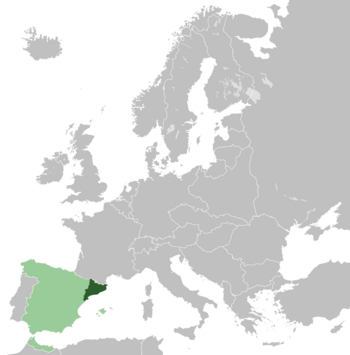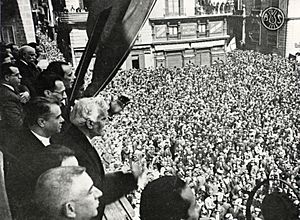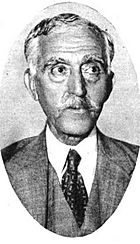Catalan Republic (1931) facts for kids
Quick facts for kids
Catalan Republic
República Catalana (Catalan)
|
|||||||||||
|---|---|---|---|---|---|---|---|---|---|---|---|
| 1931 | |||||||||||
|
Flag
|
|||||||||||

Location of the Catalan Republic within Europe
|
|||||||||||
| Status | Republic within Iberian Federation | ||||||||||
| Capital | Barcelona | ||||||||||
| Common languages | |||||||||||
| Demonym(s) | Catalan | ||||||||||
| Government | Unitary republic under provisional government | ||||||||||
| President | |||||||||||
|
• 1931
|
Francesc Macià | ||||||||||
| Historical era | Interwar period | ||||||||||
|
• Proclaimed
|
14 April 1931 | ||||||||||
|
• Establishment of the Generalitat
|
17 April 1931 | ||||||||||
|
|||||||||||
| Today part of | Spain ∟ Catalonia |
||||||||||
The Catalan Republic (Catalan: República Catalana) was a short-lived state in Catalonia, Spain. It was declared in 1931 by Francesc Macià. He wanted it to be part of a bigger "Iberian Federation" with other parts of Spain. This happened when the Second Spanish Republic was also being formed. The Catalan Republic was announced on April 14, 1931. Just three days later, on April 17, it changed into the Generalitat de Catalunya. This became the official self-governing body for Catalonia within the new Spanish Republic.
Contents
History of the Catalan Republic
How the Republic Was Declared

After a time when Spain was ruled by a dictator, different political groups wanted a new government. They met in 1930 and agreed to work together. They planned for Catalonia to have its own self-government within a new Spanish Republic.
On April 12, 1931, local elections were held. In Catalonia, a new party called the Republican Left of Catalonia (ERC) won many votes. This party had just been formed a few weeks earlier. Its leader was Francesc Macià.
Two days later, on April 14, 1931, something big happened. The Second Spanish Republic was about to be declared in Madrid. But a few hours before that, Francesc Macià made his own announcement in Barcelona. From the balcony of the Palau de la Generalitat, he declared the "Catalan Republic." He hoped that other parts of Spain would also become republics. Then, they could all form an "Iberian Confederation" together.
Before Macià's speech, another ERC member, Lluís Companys, had already announced the Spanish Republic from the City Hall. The Catalan and Spanish Republic flags were raised. Francesc Macià then became the president of Catalonia. The elected officials of Barcelona supported his new role.
Who Was in Charge?
Francesc Macià quickly started making changes. He replaced the head of the Spanish Army in Catalonia with a general loyal to the new republican government. Lluís Companys became the civil governor of Barcelona. Jaume Aiguader was named the mayor of Barcelona.
Macià also chose the people for his new Catalan government. Most of them were from his own party, the Republican Left of Catalonia. He also included members from other groups. These included a trade union and other political parties. He even offered a position to a large workers' union, but they chose not to join.
The first government of the Catalan Republic included:
- President: Francesc Macià
- Minister of Politics: Ventura Gassol
- Minister of Instruction: Rafael Campalans
- Minister of Defence: Joan Casanovas
- Minister of the Treasury: Casimir Giralt
- Minister of Economy and Work: Manuel Serra i Moret
- Minister of Communications: Manuel Carrasco i Formiguera
- Minister of Public Works: Salvador Vidal Rosell
Making Rules and Changes
The new Catalan government quickly began to take control. They told every town in Catalonia to announce the Republic. They also sent government representatives to other provinces like Girona, Lleida, and Tarragona.
A group of volunteers called the Civic Republican Guard was formed. Their job was to protect the government buildings. On April 15, a new rule was made. It said that Catalan would be the official language. On the same day, Macià allowed a radio station to broadcast freely. The first official newspaper of the Catalan Republic was published on April 16.
The Agreement and What Happened Next
The new Spanish Republic's government in Madrid was worried. They saw that Catalonia had declared its own republic. This created two different governments at the same time. So, on April 17, just three days after the Catalan Republic was announced, three Spanish ministers came to Barcelona. They wanted to talk with Macià and his government.
After long discussions, they reached an agreement. The government of the Catalan Republic changed its name. It became the Generalitat de Catalunya. This meant it was a self-governing body for Catalonia. But it was now part of the new Spanish Republic.
Catalonia would later get its own special set of rules for self-government. This was called a Statute of Autonomy. It was approved in 1932 after elections for Spain's Parliament. Francesc Macià became the President of the Generalitat of Catalonia. He held this important position until he passed away in December 1933.
See also
 In Spanish: República Catalana (1931) para niños
In Spanish: República Catalana (1931) para niños
- 1931 in Catalonia
- 1931 in Spain



